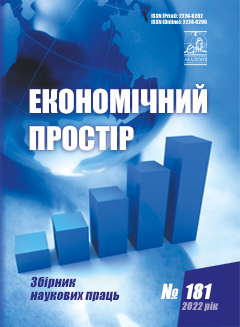МЕТОДИ УПРАВЛІННЯ КОМАНДОЮ: АСПЕКТ САМООРГАНІЗАЦІЇ
Анотація
В статті розглянуті методи управління персоналом та особливості їх застосування для ефективного управління командою. Використовуючи методи аналізу, синтезу, спостереження та виокремлення головного, сформовані топ-10 принципів формування та управління командою. Досліджена роль самокерованої мікросистеми, якою являється працівник в ефективній діяльності підприємства. Враховані складові зазначеної мікросистеми: самоорганізація, самомотивація, самодисципліна та самоконтроль. Зроблена спроба довести доцільність застосування командного менеджменту в умовах кризи та війни. Наведені переваги командної роботи для працівників, враховуючи об’єктивні реалії їх функціонування та психоемоційний фон людей в умовах війни. Досліджений аспект самоорганізації працівників, як передумова результативного та ефективного професійного та особистого життя, засобу підвищення рівня резильєнтності в сучасних умовах. Наведені актуальні методи підвищення рівня самоорганізації. Визначена роль офіційного менеджменту в процесі формування та підвищення рівня самоорганізації працівників.
Посилання
Маккрістал С., Фасселл К., Коллінс Т., Сильверман Д. Команда команд. Київ: Моноліт-Bizz. 2018. 416 с.
Кеннеді Д. Безжальний менеджмент та ефективність людських ресурсів. Харків: Фабула, 2019. 304 с.
Хемел Г., Заніні М. Людинократія. Створення компаній, в яких люди - понад усе. Київ: Лабораторія, 2021. 336 с.
Duhigg C. What Google Learned From Its Quest to Build the Perfect Team. New research reveals surprising truths about why some work groups thrive and others falter. The New York Times Magazine. 2016. URL: https://www.nytimes.com/2016/02/28/magazine/what-google-learned-from-its-quest-to-build-the-perfect-team.html (дата звернення 28.10.2022).
Лайнбек К., Хілл Л., Брандо Г., Трулав Е. Командна робота. Як впровадити зміни в компанії, щоб вас підтримали. Київ: Наш формат, 2019, 328 с.
Бондаренко Е. Успешный руководитель. 50 проверенных инструментов на каждый день. Днепр: Баланс Бизнес Букс, 2020. 248 с.
Муха Р. А. Команда, її сутність та особливості розвитку. Ефективна економіка. 2015. № 8. URL: http://www.economy.nayka.com.ua/?op=1&z=4253 (дата звернення 28.10.2022).
Шпортько Г. Ю., Карабаш А. Г. Дослідження формування ефективної управлінської команди. Економіка та суспільство. 2021. Вип. 25. URL: https://www.economyandsociety.in.ua (дата звернення 28.10.2022).
Шавкун І. Г. Командний менеджмент: аксіологічний вимір. Гуманітарний вісник ЗДІА. 2010. Вип. 42. с. 218-226.
Хитра О. В.,Атаманюк Р. І. Компетентнісно-рольовий підхід до формування робочих команд. URL: http://elar.khmnu.edu.ua/jspui/bitstream/123456789/5168/1/Khytra_Atamanyuk.PDF (дата звернення 28.10.2022).
Данюк В.М., Петюх В.М., Цимбалюк С.О. Менеджмент персоналу: навч. посіб. Вид. 2-ге, без змін. Київ: КНЕУ, 2006. 398 с.
Голубка О. Я., Дідович Ю.О., Копусяк Я.Ф. Аналіз методів управління персоналом. Економічний вісник Запорізької державної інженерної академії. 2016. Випуск 5-1 (05). С. 113-117.
Раєвнєва О. В. Управління розвитком підприємства: методологія, механізми, моделі : монографія. Харків: ІНЖЕК, 2016. 496 с.
Ткаченко А. М., Морщенко Т. С. Стратегічні напрямки удосконалення управління персоналом : монографія. Запоріжжя : Вид-во Запорізької державної інженерної академії, 2018. 234 с.
Новікова М. М., Мажник Л. О. Технологія управління персоналом: теоретичні та методичні аспекти : монографія. Харків: Хар. нац. акад. міськ. госп-ва, 2012. 261 с.
Ващенко Н. В. Адаптація принципів та методів управління персоналом у процесі управління підприємством. Економічний часопис ХХІ. 2014. №1-2(1). С. 98-101.
Ливч Д. Як створити ефективну команду. URL: https://buduysvoe.com/publications/yak-stvoryty-efektyvnu-komandu (дата звернення 29.10.2022).
Hickman A. The 5 Tactics of Teamwork: A Blueprint for Team Management. URL: https://www.gallup.com/workplace/275387/tactics-teamwork-blueprint-team-management.aspx (дата звернення 29.10.2022).
Makkristal S., Fassell K., Kollins T., Sylverman D. (2018) Komanda komand [Team of teams]. Kyiv: Monolith-Bizz, 416 p. (in Ukrainian).
Kennedi D. (2019) Bezzhalnyi menedzhment ta efektyvnist liudskykh resursiv. [Ruthless management and efficiency of human resources]. Kharkiv: Fabula, 304p. (in Ukrainian).
Khemel H., Zanini M. (2021) Liudynokratiia. Stvorennia kompanii, v yakykh liudy - ponad use. [Humanocracy. Creation of companies where people are above all]. Kyiv: Laboratory, 336p. (in Ukrainian).
Duhigg C. (2016) What Google Learned From Its Quest to Build the Perfect Team. New research reveals surprising truths about why some work groups thrive and others falter. The New York Times Magazine. Available at: https://www.nytimes.com/2016/02/28/magazine/what-google-learned-from-its-quest-to-build-the-perfect-team.html (accessed 28 October 2022).
Lainbek K., Khill L., Brando H., Trulav E. (2019) Komandna robota. Yak vprovadyty zminy v kompanii, shchob vas pidtrymaly. [Teamwork. How to implement changes in the company to be supported]. Kyiv: Our format, 328p. (in Ukrainian).
Bondarenko E. (2020) Uspeshniy rukovodytel. 50 proverennikh ynstrumentov na kazhdiy den. [The Successful Leader. 50 proven tools for every day]. Dnieper: Balance Business Books, 348p. (in Ukrainian).
Mukha R. A. (2015) Komanda, yii sutnist ta osoblyvosti rozvytku. [Team, its essence and features of development]. Efektyvna ekonomika, no 8. Available at: http://www.economy.nayka.com.ua/?op=1&z=4253 (accessed 28 October 2022).
Shportko H. Yu., Karabash A. H. (2021) Doslidzhennia formuvannia efektyvnoï upravlinskoï komandy. [Study of the formation of an effective management team]. Ekonomika ta suspilstvo, vol. 25. Available at: https://www.economyandsociety.in.ua (accessed 28 October 2022).
Shavkun I. H. (2010) Komandnyi menedzhment: aksiolohichnyi vymir. [Team management: axiological dimension]. Humanitarnyi visnyk ZDIA, vol. 42, pp. 218-226.
Khytra O. V., Atamaniuk R. I. Kompetentnisno-rolovyi pidkhid do formuvannia robochykh komand. [Competence-role approach to the formation of working teams]. Available at: http://elar.khmnu.edu.ua/jspui/bitstream/123456789/5168/1/Khytra_Atamanyuk.PDF (accessed 28 October 2022).
Daniuk V.M., Petiukh V.M., Tsymbaliuk S.O. (2006) Menedzhment personalu. [Personnel management]. Kyiv: KNEU, 398 p. (in Ukrainian).
Holubka O. Ya., Didovych Yu.O., Kopusiak Ya.F. (2016) Analiz metodiv upravlinnia personalom. [Analysis of personnel management methods]. Ekonomichnyi visnyk Zaporizkoi derzhavnoi inzhenernoi akademii, vol. 5-1 (05), pp. 113-117.
Raievnieva O. V. (2016) Upravlinnia rozvytkom pidpryiemstva: metodolohiia, mekhanizmy, modeli [Enterprise development management: methodology, mechanisms, models]. Kharkiv: INJEC, 396p. (in Ukrainian).
Tkachenko A. M., Morshchenko T. S. (2018) Stratehichni napriamky udoskonalennia upravlinnia personalom [Strategic directions of improvement of personnel management]. Zaporizhzhya: Publishing house of Zaporizhzhya State Engineering Academy, 324p. (in Ukrainian).
Novikova M. M., Mazhnyk L. O. (2012) Tekhnolohiia upravlinnia personalom: teoretychni ta metodychni aspekty [Technology of personnel management: theoretical and methodological aspects]. Kharkiv: Kharkiv National Academy of Municipal Economy, 361 p. (in Ukrainian).
Vashchenko N. V. (2014) Adaptatsiia pryntsypiv ta metodiv upravlinnia personalom u protsesi upravlinnia pidpryiemstvom. [Adaptation of principles and methods of personnel management in the process of enterprise management]. Ekonomichnyi chasopys KhKhI, vol. 1-2(1). pp. 98-101.
Lyvch D. Yak stvoryty efektyvnu komandu. [How to create an effective team]. Available at: https://buduysvoe.com/publications/yak-stvoryty-efektyvnu-komandu (accessed 29 October 2022).
Hickman A. The 5 Tactics of Teamwork: A Blueprint for Team Management. Available at: https://www.gallup.com/workplace/275387/tactics-teamwork-blueprint-team-management.aspx (accessed 29 October 2022).



